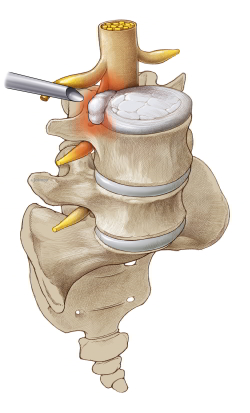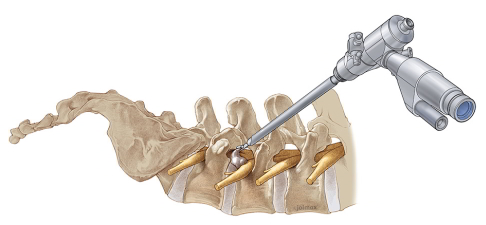Minimally Invasive Spine (MIS) or Endoscopic Spine Surgery
Minimal invasive spine surgery fills the gap between conservative pain therapy and surgery
 A herniated disc is putting pressure on a nerve root: Open surgery VS Endoscopic Spine Surgery? A disc herniation can be identified and removed through a tubular device without open back surgery. © Joimax
A herniated disc is putting pressure on a nerve root: Open surgery VS Endoscopic Spine Surgery? A disc herniation can be identified and removed through a tubular device without open back surgery. © Joimax
Spinal surgery should always be the last resort when it comes to treating chronic back pain.
The spinal cord is part of the central nervous system. The density of important nerves in the area around the spine makes this area particularly vulnerable to the side effects of open back surgery. In many cases, open back surgery is not successful in reducing back pain. One of the reasons for this "failed back surgery" is the formation of scar tissue in the area of the spine following the surgery.
Avoiding trauma and tissue injury (which is inevitable with open spine surgery), is the main advantage of minimally invasive spine surgery. Large-scale, often painfully irritating, surgical scars are avoided. A successful endoscopic spine operation requires precise diagnostics and localisation of the root cause. This requires the surgeon to have highly sophisticated diagnostic and neurosurgical training.
PD Dr. David-Christopher Kubosch as a Senior consultant for Neurosurgery, has experience in spinal - and neurosurgery. He is a highly dedicated and experienced diagnostic expert, with a passion for ascertaining the root cause of chronic back pain.
Technical background and equipment required
Requirements for MIS-Spine Surgery
- High resolution X-ray vision and imaging devices
- Highly developed spine navigation software
- Endoscopic equipment
- Highly trained surgical team
- High tech diagnostic facilities (MRI)
- Neurosurgical diagnostic training
- Ability to combine Minimally Invasive Endoscopy with Radiofrequency Techniques (IDET)
- Ability to combine MIS with Laser Surgery
The advantages of minimally invasive surgery have been known for decades. In many areas of medicine and particularly in orthopaedics, minimally invasive procedures are already standard.
However, the area of spine surgery, was one of the last areas of medical expertise, to successfully enter the age of minimally invasive intervention. This delay was partly due to the high technical requirements in this field of medicine.
The surgeon requires high resolution intra operative x-ray guidance and effective image converters. The endoscopic devices for minimally invasive spine surgery require high resolution optics. This equipment can be very expensive and the training is very demanding. This is one of the reasons, why endoscopic spine surgery (MIS) is offered in only relatively few clinics.
Example of Endoscopic Spine Surgery: Percutaneous Disc Nucleoplasty
The last and most important condition for successful minimally invasive spine surgery, is a highly trained surgical team, which together has mastered this particularly demanding area of surgery. The limited area for endoscopic vision and the surgical action required in the target area, are very demanding in terms of the surgeon’s diagnostic expertise, technical abilities and surgical performance.
How is endoscopic spine surgery performed?
Open Back Surgery - Possible Complications
- Lesion of Blood vessels
- Lesion of Nerves
- Bone Surgery
- Higher incidents of postsurgical complications
- Higher risk of infection due to longer rehabilitation
- Sutures and suture removal
- Wound healing takes longer
- Formation of irritating, often chronically painful scar tissue
Surgery through a tubular device avoids large incisions in skin, muscles, nerves and bones. The typical endoscopic access to the spine requires an incision of less than 1 cm.
For both spinal disc protrusion and for spinal disc herniation, the endoscopic approach has been particularly successful in avoiding open surgery in the last two decades.
Endoscopic Spine Surgery uses Natural Access
Endoscopic Spine surgery uses the pre-existing access routes into the spine, in order to avoid trauma to bones and muscles. The use of these pre-existing access routes however, limits the application of endoscopic surgery. If a particular problem area can not be reached through a natural opening, open surgical access through the bones around the spinal cord is required.
Conditions successfully treated by Minimally Invasive Spine Surgery (MIS)
- Disc Protrusion
- Degenerative Disc Disease
- Herniated Discs
- Lumbar Spinal Stenosis
- Osteoporotic Vertebral Compression Fractures
- Spinal Infections
- Osteoarthritis of Facet Joints
 Surgery through a tubular device, avoids large incisions in skin, muscles, nerves and bones. The typical endoscopic access to the spine requires an incision of less than 1 cm. © Joimax
Surgery through a tubular device, avoids large incisions in skin, muscles, nerves and bones. The typical endoscopic access to the spine requires an incision of less than 1 cm. © Joimax
Endoscopic Spine Surgery Step by Step
Advantages of MIS in comparison to open spine surgery
- Smaller incision: faster recovery for patient
- Reduced blood loss, quicker recovery
- Smaller incision: less pain after surgery
- Less soft tissue damage: no scar formation
- Smaller surgical wound: less risk of complication, faster return to work
- Local anaesthesia: reduced surgical risk
It is possible for most of the complications of open back surgery to occur with endoscopic spine surgery (MIS), but they occur much less frequently.
- Local anaesthesia and sedation
- Skin incision of 5-6 mm
- Endoscope (camera in a small tube) is inserted into the incision as a working channel
- The endoscope is guided to the painful site inside the spinal cord, under constant X-ray control
- A camera inside the endoscope shows the spinal disc and nerve roots
- Material from herniated spinal discs can be removed through small instruments.
- Constant supervision and documentation of the surgery with the endoscopic camera.
- After 30-45 mins the procedure is finished.
- No sutures are required.
- Immediate mobilisation of the patient on the day of the surgery is possible.
- Physiotherapy starts the day after endoscopic back surgery. Treatment should be continued as outpatient physiotherapy.
Limits of Minimally Invasive Spine Surgery
When will your spine specialist suggest an alternative treatment?
- Severe spinal stenosis
- Scoliosis
- Cervical disc herniations
- Spondylolisthesis (slipped vertebra)
- Ankylosing spondylitis (Morbus Bechterew)
- Spondylosis (degenerative osteoarthritis of the joints between the centre of the spinal vertebrae and neural foramina)
- Disc Herniations with the Herniation beyond the reach of the endoscope (via transforaminal access)
Minimally invasive spine surgery is very promising and has the distinct advantage of all endoscopic surgery (avoiding soft tissue and bone trauma). It gives the patient a much faster recovery, with reduced surgical risk. But compared to other surgical approaches to spine surgery such as microsurgical open spine surgery (under the microscope) MIS spine surgery is relatively new.
- Clinical research is still limited for many MIS techniques and indications. The short-term results are very good, but long-term-follow-up data is limited.
- Lack of established guidelines for MIS: Many decisions involving Minimally Invasive Spine Surgery do not depend on established guidelines but on the individual experience of a highly specialised surgeon.
- The limited field of vision under endoscopic view reduces the ability to respond to intraoperative events. In some cases the endoscopic approach might have to become open spine surgery during the procedure, if the situation turns out to be different to expected. For example, a disc herniation can be larger than expected, or the eruption includes areas of the spine not yet accessible by endoscope.
- MIS-training is not yet part of the standard training for spine surgeons in many training centres. Patients should check the experience and training of their spine surgeon very carefully.




